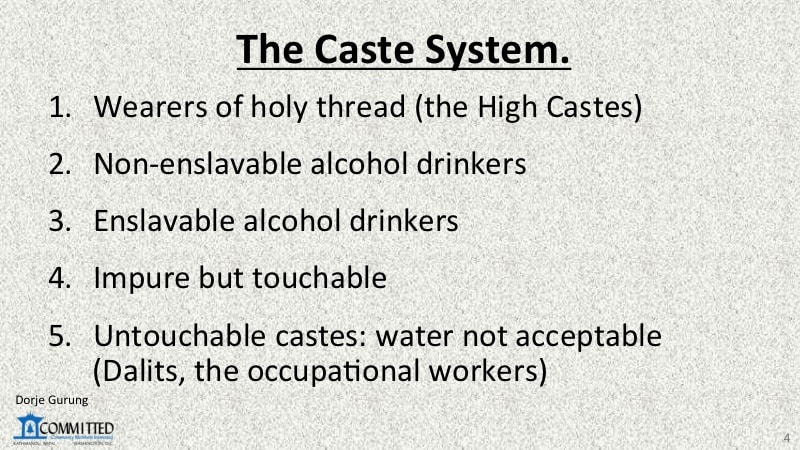One of the many many consequences of the poor quality of education in Nepal is the inability of many Nepalis to make logical arguments.
Most arguments Nepalis make are emotional arguments. Most of the rest of the arguments meant to appeal to reason are often fallacy ridden (click here and here for just two examples). Ad hominem aguments are used by average Joes, political leaders, and even officials routinely, as are Whataboutism and straw man arguments. Another one still is false-equivalence arguments.
When discussing with — but not limited to — hill so-called high caste Hindus (Brahmins/Brahmans/Bahuns and Chhetris), the Khas-aryas, about disparity in success between themselves and other caste groups in the country, they have put forth false-equivalence arguments. They say how it’s not easy for the Khas-aryas to achieve success either. The screenshot below is one example.

The following is another example
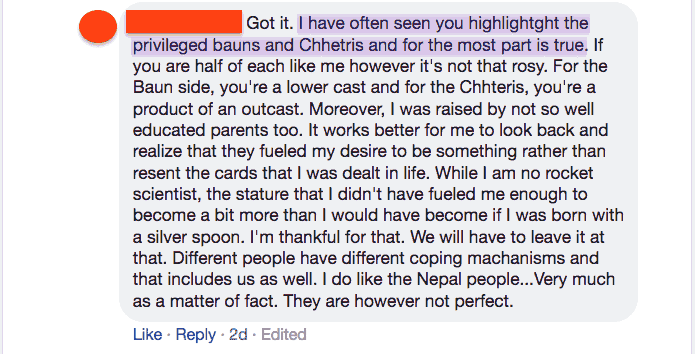
Ether they are disingenuous OR they don’t know that they are making a flawed argument.
I tend to believe it’s the latter because of the combination of the low quality of education in the country and the tendency of privilege to blind people.
To restate their argument: “Sure, the Dalits and other castes in the country struggled to succeed in life. So did I! I may have been born a hill so-called high caste Hindu, but I had to work really hard to get to where I am today. Everyone should work hard and overcome the adverse circumstances one is born into instead of seeking special treatment [i.e. affirmative action].”
They make three implicit assumptions in the argument.
The first one is that everyone must put in a lot of effort to be successful (which isn’t necessarily true). The second is that those who expend the necessary effort are successful and those who don’t aren’t (which again isn’t necessarily true either). The third is that, therefore, challenges faced by different castes are similar or equivalent (which is COMPLETELY false!).
(On a kind of a strange side note, I am pretty sure that the basis for the inclusion of the provision in the 2015 constitution granting affirmative action (referred to as “reservation” in the Indian Subcontinent) to…poor hill so-called high caste Hindus (along with the historically marginalized and disenfranchised groups) was also a false-equivalence argument! After all, hill so-called high caste Hindus were disproportionately highly represented in the Constituent Assembly.)
The actual case is that, whether one becomes “successful” in the highly stratified and graded Nepali society — mostly along caste and sub-caste lines because of the entrenched caste system — depends a lot on the caste you are born into!
Not all are born equal in Nepal. The playing field in Nepal is NOT level.
Climbing Mount Everest would be an apt analogy for life in the country to clearly delineate and expose how and why that is so and thereby breakdown the false-equivalence argument. But before that, here are the details of the caste system as first spelled out in the Muluki Ain (the Law of the Land, i.e. The Constitution) of 1854.
And the legacy of that? The gradation by caste in any metric you choose to compare the groups. Here’s evidence from 1996 using literacy and income.
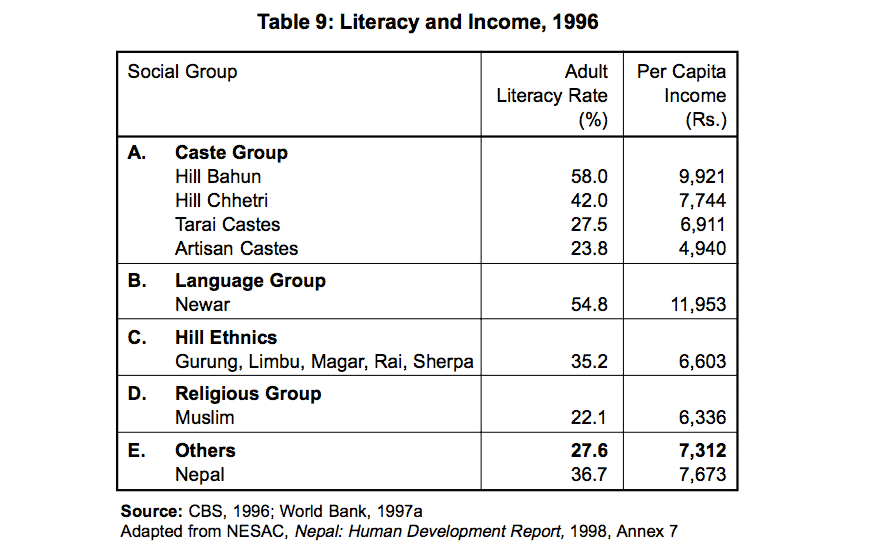
When it comes to both Literacy Rates and Per Capita Income, the top three are the Newars, the Hill Bahun and Hill Chhetri. What Dr. Gurung labels “Artisan Castes” are the Dalits, whose PCI is the lowest, and Literacy Rate is the second lowest (slightly more than that of the Muslims who are NOT part of the caste system). The other castes, such as the Hill Ethnics, as you can see, rank between the highest and the lowest castes.
And here’s more recent data confirming the same.
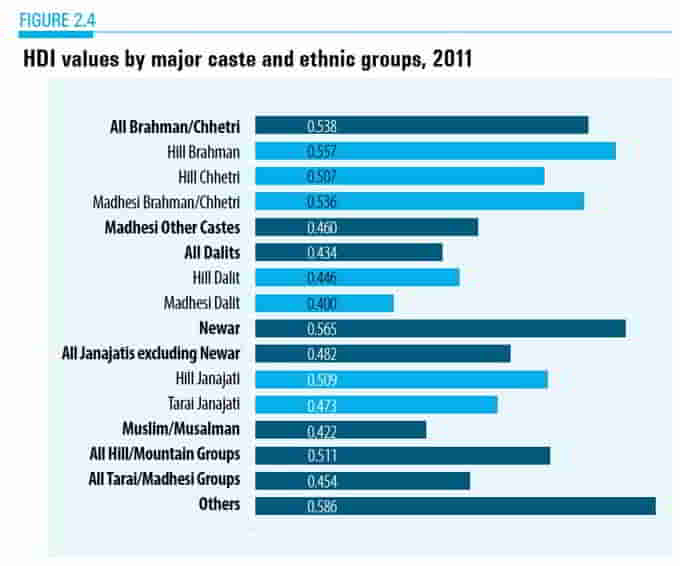
The pattern in HDI is pretty much the same as that in Litreacy and Income. The Hill Brahman are ranked second (after the Newars) and Hill Chhetri are ranked fourth. The Dalits, as a group, with a score of 0.434 is the second lowest. (The Muslims are at the bottom.)
Now, let’s go climbing!
Let’s imagine Mount Everest to be the world of Nepal and that the lives of Nepalis consisted of conquering it!
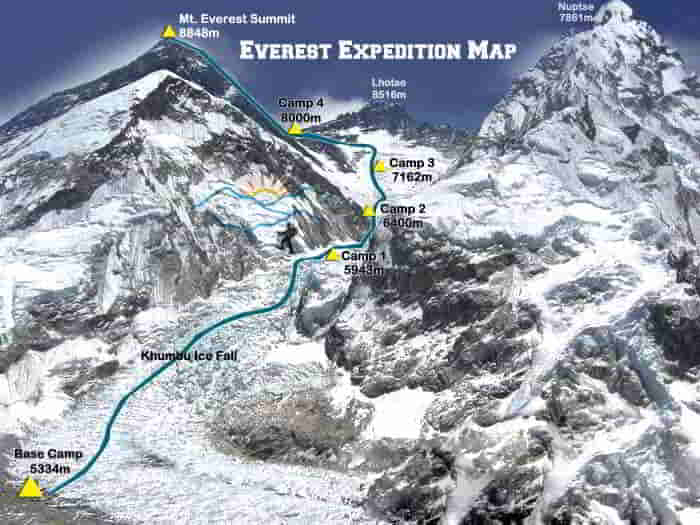
In this scenario, the Khas-aryas would have been “born in” — and would start their “life’s journey” from — Camp 4 (see map above). At 8000m, Camp 4 is the highest camp and therefore the closest to the summit. The other castes would have been born in and would start their ascent from camps lower down — Camp 3, Camp 2, and Camp 1. The Dalits, the fifth and the lowest caste, would have been born in and would start theirs from Base Camp.
Sure, most, including many hill so-called high castes, must struggle and “work hard” to summit Everest.
It’s still over 800m from Camp 4 to the summit. BUT the challenges faced by the hill so-called high castes pale in comparison to the ones faced by those starting from lower camps. The struggles are NOT the same or equivalent at all! The playing field in Nepal, as I am sure you have realized, is mountainous and a steep climb to the finish line!
To take a step back though, you might be wondering how it is that Khas-aryas start their lives closest to the summit!
As a group, they are born with and enjoy structural privileges.
The constitutions (such as the Muluki Ain of 1854 and the Constitution of 2015), the laws, the systems, and the structures in the country have all worked for the Khas-aryas. Which of course is NOT surprising since they have been pretty much ALL set up by and run mostly by them. (On a side note, being able to say, as a hill so-called high caste Hindu, that “I don’t really identify with any caste” is ALSO a privilege NO other caste enjoys!)
Since, as a group, they have enjoyed so much more privileges throughout the history of the country, they are born into a socio-economic context and circumstance in which they enjoy a great deal of social capital, more than any other caste as attested to by the Literacy and Income and HDI tables above.
Here’s one more evidence of that: the hill so-called high caste Hindus have been disproportionately highly represented in the parliament (see chart below). The hill so-called high caste Hindus make up about 31% of the population according to the 2011 Census Report.
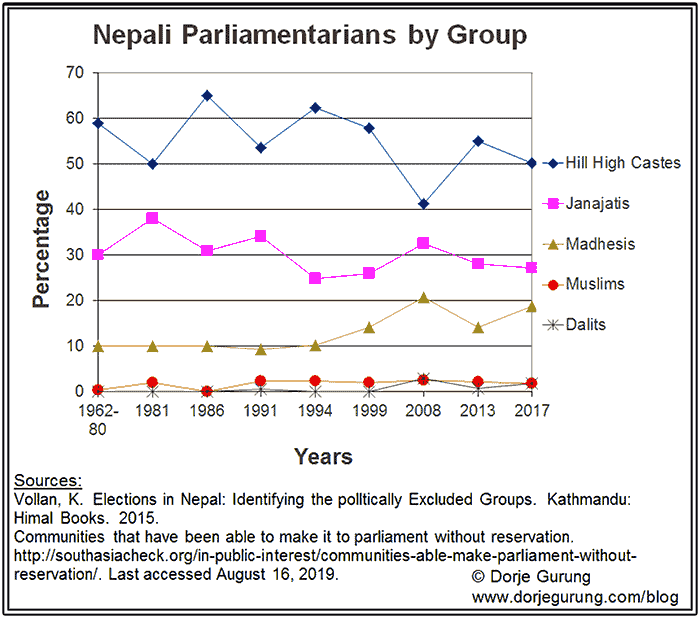
Returning to the mountain…what’s more, among the hill so-called high caste Hindus in Camp 4 are EVEN those who can count on their “support team” (social capital) to just lead — or carry — them to the summit. In other words, there are those born Khas-aryas who don’t have to really put in any significant amount of individual effort! There are Khas-aryas who are born with a silver spoon in their mouth (such as those with royal blood to give but just one example)!
That is NOT to say that no one in Camps 3, 2, and 1 is born into ANY kind of privilege!
Some from those in lower camps are also born into some privilege — class privilege for instance — and receive some such support. What is true, however, is that the percentage of Khas-aryas who are able to “succeed” with minimal or next to no effort is significantly higher than the percentage of those belonging to other castes and starting their climb lower down the mountainside.
Take me and my family for example.
In my pretty big extended family, I am one of about forty first cousins. Being Bhote, a lower caste according to the caste system, we would have been born in Camp 2. Born into poor families with next to no educational history and no connection to any family or group of any import or influence, most of us weren’t even expected to go to school. A number of my first cousins never made it to school! A number of those that did never made it past primary school or secondary school etc. Only about five of us were able to obtain a college degree.
I am the only one with advanced degrees from educational institutions abroad, however, and one of maybe just two of us with a professional career. So, how many of us made it to the summit? I would say just me!
I am willing to bet that, were we to compare the accomplishments of my generation belonging to my extended family to that of the accomplishments of a hill so-called high caste Hindu classmate of mine and his first cousins, we would find a HUGE disparity!
Moving on down the Mountain…to Base Camp, to the Dalits who struggle the most.
Just to get to Camp 1, they have to navigate past the most treacherous part of the climb: the Khumbu ice falls (see image above). NO other caste even come across it on their way to the top!
No other caste in the country, as a group, faces anywhere near as much discrimination personally, socially, and encounters anywhere near as many — and as often — the systemic, institutional, and structural BARRIERS to advancement as the Dalits do. (Incidentally, I have also had many Nepalis argue that there is very little or no caste-based discrimination in the country.) Forget about anyone or even the State providing any significant support to give them a “leg up” — because none of them are at Base Camp with the Dalits! All of that, of course, is the reason behind their being at the very, or near, the bottom on any and every indices.
Only after a Dalit overcomes all those barriers and personal hardships, with great personal effort surpassing that of any other caste, to educate himself that he — yes he — is able to ATTEMPT to have a shot at the life all other castes are BORN into above the ice falls.
Following that, attempting the summit AND potentially standing shoulder to shoulder with other summiteers is yet another challenge! (I say potentially because even at the summit, he will likely struggle to be accepted by the others there.)
(A vast majority of Dalit women would struggle to get past the Khumbu ice falls not because they do not apply themselves sufficiently or because they are NOT capable, but rather because they are held back and hindered so so much more.)
So, returning to their false-equivalence argument, the hill so-called high caste Hindus adding that they don’t have it easy either is like saying how difficult the Hilary Step is on the way to the summit!
In saying so, they are displaying a complete ignorance of (or are in denial of) the fact that the rest of the castes have to get to Camp 4 first, long before they can even attempt Hillary Step!
To reiterate something I have said in the past: a hill so-called high caste may suffer in ways that other castes do too (like from poverty), BUT they do NOT suffer BECAUSE they are hill so-called high caste! One of the many ways other castes suffer from is simply for being the the caste they are, or, put another way, for NOT being a hill so-called high caste Hindu!
In other words,
“Khas privilege doesn’t mean your life hasn’t been hard; it means that your caste isn’t one of the things making it harder.”
(The above conclusion was modeled after this meme about White privilege and skin color.)
And what’s the solution to Nepalis’ inability to argue logically? Part of the solution is to teach philosophy in our educational institutions, something I have also said in the past here and here.
p.s. Of course, it goes without saying but…if you take the analogy any further it’ll break down, or it will miss the point, which a Nepali did with another analogy.
* * * * * * * *
References:
- The Kathmandu Post (April, 2019). This is what it takes to get a foreigner to Everest.
- Alan Arnette.com (March 2017). Why is the Khumbu Icefall So Dangerous.
- The Record (April 2019). Lying to survive: Dalits in urban life.
- The Kathmandu Post (Feb. 5, 2019). Structural blindness.
- The Kathmandu Post (April, 2019), For this season’s Everest climbers, it’s all systems go—except the weather.
The following is not referenced in the blog but I share it here for its relevance.
- Imagine Nepal Treks and Expedition (no date). MT. EVEREST (8848) EXPEDITION VIA NEPAL 2020.
- Nepal Samaj (No date). पहिलो मुलुकी ऐनमा जात हेरी दण्ड. “In the First Constitution Caste-based Punishments.” [Added Jan. 25, 2020.]
- Outside (Dec. 30, 2021). An Everest Guide Just Won a Legal Battle over a Canceled Summit Attempt. “The serac was estimated to be the size of a 15-story building, even larger than a similar ice block that had collapsed onto the same area in April 2014, killing 16 Sherpas working on the Khumbu Icefall between Base Camp and Camp I.” [Added on Jan. 5, 2022.]

